I cooked curry tonight for Joe and I, It was a fish curry from Jamie's latest magazine ( I will definitely add that to the blog soon) but I also wanted Dahl. I texted our friend Nushi who makes a legendarily good Dahl, but while I was waiting for a response I found this article from the Guardian ... I ended up cooking this one which according to Joe was pretty bloody good. However here is the precise details of Nushi's text to me ... not that precise
Nushi's dahl
The Guardian article
Nushi's dahl
ok- dhal- wash, soak, add to boiling water, spoon of any scummy bits. add salt, 1 tsp red chilli powder, turmeric- quarter teaspoon once cooked ,
part two! in a seperate pot heat some oil and add finely sliced garlic, as soon as they are pinky brown add teaspoon whole cumin, once sizzling and turning darker add it to the dhal- careful of spultering! add coriander and hey presto!
Sent from my iPhone
Sent from my iPhone
The Guardian article
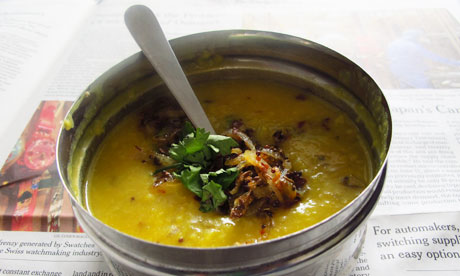
Felicity's perfect dal. Photograph: Felicity Cloake for the Guardian
Not all comfort food transcends cultures. I find it difficult to imagine turning to spam fried rice to mend a broken heart, or stuffed cabbage to banish winter blues (although this recipe does sound pretty damn good), but I fell in love with the soupy, wholesome qualities of dal on our very first meeting.
Unlike many of its British equivalents (mash, hotpot, steamed puddings, even the surprisingly similar pease puddings which preceded the potato in this country), dal is a dish which can comfort all year round: the fresh, sharp spices and clean herbs work as well for me on a cooling summer evening as a dark winter's night. Madhur Jaffrey writes evocatively of the "deep satisfaction" of the dish – "you can take meats and fish and vegetables from an Indian" she says in her Curry Bible, but you cannot take away his dal – "the core of his meal".
As the Oxford Companion to Food points out, technically the word denotes simply a split pulse, but in India it has come to encompass all dried peas and beans, as well as dishes in which they are the principal ingredient – "of which," the authors explain, somewhat dauntingly, "there are least 60 kinds". To prevent this survey descending into madness, I've limited myself to the sort I cook most often, by virtue of its sheer simplicity, mung dal, which Madhur claims has "always been considered the most digestible" and is eaten "with equal relish by toothless toddlers, husky farmers and effete urban snobs." Pigeon peas and sambar must be left, regretfully, for another occasion.
As the Oxford Companion to Food points out, technically the word denotes simply a split pulse, but in India it has come to encompass all dried peas and beans, as well as dishes in which they are the principal ingredient – "of which," the authors explain, somewhat dauntingly, "there are least 60 kinds". To prevent this survey descending into madness, I've limited myself to the sort I cook most often, by virtue of its sheer simplicity, mung dal, which Madhur claims has "always been considered the most digestible" and is eaten "with equal relish by toothless toddlers, husky farmers and effete urban snobs." Pigeon peas and sambar must be left, regretfully, for another occasion.
A bit of a soak?
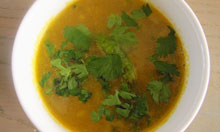 Simon Daley dal. Photograph: Felicity Cloake for the Guardian
Simon Daley dal. Photograph: Felicity Cloake for the Guardian
Traditionally, according to my trusty Oxford Companion, mung dal would have been soaked before cooking, to save fuel – in these profligate days, I can only find one recipe which calls for such a step, in the excellent Riverford Farm Cook Book. Madhur's own, meanwhile, as handed down from on high in The Essential Madhur Jaffrey, calls for them to be simmered for an hour and a half; far longer than the standard 20–30 minutes I find elsewhere.
After experimenting, however, I begin to realise that the aim when cooking dal is to achieve a blessedly comforting creaminess, which can only come from pulses that have thoroughly broken down. Soaking hastens this process, and you can also cheat and, as, as recommended in Simon Daley's Cooking with my Indian Mother-in-Law (a book I highly recommend), take a whisk to the cooked dal and beat it into smooth submission, but having tried all three methods, long slow cooking produces by far the best result. Madhur's dal has an unctuous silkiness which sets it apart from the others – and is well worth waiting for.
Cooking liquid
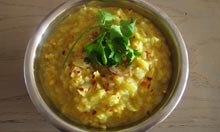 Riverford dal. Photograph: Felicity Cloake for the Guardian
Riverford dal. Photograph: Felicity Cloake for the Guardian
The Riverford recipe (which in its entirety contains the cauliflower and potatoes to be found in their autumnal and winter vegetable boxes, although I've omitted these to make it a fair comparison) cooks the pulses in vegetable stock, rather than the more usual water. Although you might think that pulses could do with a helping hand in the flavour stakes, in fact, most dals contain so much spice that the blandness of the legumes is an essential part of the dish – a properly seasoned dal, I decide, doesn't need any stock.
Masala zone
The Riverford dal is also unusual in that it starts by sautéing onions and celery, then adds garlic and spices, as if making the base for a stew. The problem comes when adding the pulses – they must be skimmed as they come to the boil, or the finished dal will be bitter, and with the foam comes bits of vegetable and flecks of nutmeg.
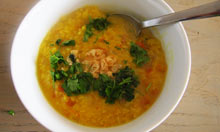 Nigel Slater dal. Photograph: Felicity Cloake for the Guardian
Nigel Slater dal. Photograph: Felicity Cloake for the Guardian
Nigel Slater's pleasingly simple recipe, which boils up raw onion, tomato, garlic and chillies along with the spices and dal, suffers from the same problem – and is also oddly bland, given it contains 6 cloves of garlic. If you're making a more complex dal, much better to go down the Simon Daley (or rather, his mother-in-law Roshan Hirani's) route and use the pulse cooking time to prepare a masala paste. Her version involves pounding together garlic, green chillies, ginger, tomatoes and salt, and then frying them with onion and spices to make a highly aromatic sauce which gives the finished dal a rich and complex flavour. I'm after something simpler, however, and Madhur's method, which cooks the pulses with chillies, turmeric, garlic and ginger, added only after skimming, gives a more delicate result.
Tarka dal
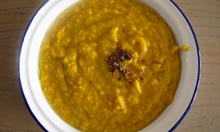 Madhur Jaffrey dal. Photograph: Felicity Cloake for the Guardian
Madhur Jaffrey dal. Photograph: Felicity Cloake for the Guardian
The final step in any dal is the tarka (also known as the baghaar or chownk) – a mix of spices fried in oil or ghee until sizzling and aromatic, and then folded through the creamy pulses just before serving. Nigel keeps it simple with fried garlic, but I prefer the thinly sliced shallots that Riverford use, sautéed until lightly golden, and then toasted with Madhur Jaffrey's cumin seeds, plus a few mustard seeds and crushed chilli flakes for colour and heat. (Ghee, or clarified butter in my opinion, gives the finished dal a richer flavour, but vegetable or groundnut oil is almost certainly the healthier option.) Riverford, and Mrs Jaffrey and Hirani all suggest adding a little lemon juice to the finished dal, but I find I prefer it without – the sharpness interferes with the all-important comfort blanket effect.
Salt?
As Anjum Amand points out in Indian Every Day, there's some controversy over when to add salt when cooking pulses – old wives claim that to do so too early makes them tough, but as Madhur Jaffrey admits, "although I follow [this] instinctively … I have seen it proved wrong time and time again". I don't find the dals salted at the beginning, like Nigel Slater's, take any longer to cook, but as you're reducing slightly, it's better to add only a little at the start to help flavour the pulses, and then adjust the seasoning at the end, or you may end up with something unpalatably saline.
Perfect dal
Dals should be cooked long and slow for maximum creaminess, and left relatively plain, the better to set off the spicy, aromatic tarka which makes such a sizzling garnish. Endlessly versatile, they can be as thin as soup, or as thick as porridge, and will take on just about any spice you throw at them, so next time you're feeling in need of cheering up, raid the rack and get cooking.
Serves 4
400g mung dal (skinned yellow split mung beans)
4 cloves garlic, peeled and crushed
4cm piece of root ginger, peeled and cut into 4
1 tbsp turmeric
4 small green chillies, 2 finely chopped, 2 left whole
2 tbsp ghee or groundnut oil
2 shallots, finely sliced
1 tbsp cumin seeds
1 tsp mustard seeds
1 tsp crushed chilli
Fresh coriander, chopped to serve
4 cloves garlic, peeled and crushed
4cm piece of root ginger, peeled and cut into 4
1 tbsp turmeric
4 small green chillies, 2 finely chopped, 2 left whole
2 tbsp ghee or groundnut oil
2 shallots, finely sliced
1 tbsp cumin seeds
1 tsp mustard seeds
1 tsp crushed chilli
Fresh coriander, chopped to serve
1. Wash the dal until the water runs clear, then drain and put in a large pan and cover with 2 litres of cold water. Bring to the boil and skim off any scum that rises to the surface.
2. Add the garlic, ginger, turmeric and chopped chillies to the pan with a pinch of salt, turn down the heat, cover, leaving the lid slightly ajar, and simmer very gently for about 1½ hours, stirring occasionally, until the dal has broken down completely and become creamy.
3. Add boiling water or reduce the dal further to achieve your preferred consistency if necessary, and season to taste – I add about 1 tsp salt – then add the whole chillies and simmer for 15 minutes.
4. Meanwhile, heat the ghee or oil in a frying pan over a medium high heat and add the shallots. Stir until golden and beginning to crisp, then add the dried spices and cook for a couple of minutes until the mustard seeds are beginning to pop. Tip over the dal, stir in, and top with chopped coriander. Serve with plain rice or flatbreads.
How highly does dal rank among your favourite comfort foods? And if it's languishing down the order, what do you turn to at this time of year when you're hungry and in need of cheering up?
Comments